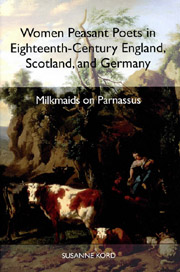Book contents
- Frontmatter
- Contents
- List of Illustrations
- Acknowledgments
- Introduction: Aesthetic Evasions and Social Consequences
- 1 Back to Nature: Bourgeois Aesthetic Theory and Lower-Class Poetic Practice
- 2 The Wild and the Civilized: Poet Making
- 3 The Life As the Work: Counterfeit Confessions, Bogus Biographies, Literary Lives
- 4 A Literature of Labor: Poetic Images of Country Life
- 5 Inspired by Nature, Inspired by Love: Two Poets on Poetic Inspiration
- 6 Of Patrons and Critics: Reading the Bourgeois Reader
- Conclusion: On the Gender and Class of Art
- Appendix: Short Biographies of Women Peasant Poets
- Works Cited
- Index
Conclusion: On the Gender and Class of Art
Published online by Cambridge University Press: 05 February 2013
- Frontmatter
- Contents
- List of Illustrations
- Acknowledgments
- Introduction: Aesthetic Evasions and Social Consequences
- 1 Back to Nature: Bourgeois Aesthetic Theory and Lower-Class Poetic Practice
- 2 The Wild and the Civilized: Poet Making
- 3 The Life As the Work: Counterfeit Confessions, Bogus Biographies, Literary Lives
- 4 A Literature of Labor: Poetic Images of Country Life
- 5 Inspired by Nature, Inspired by Love: Two Poets on Poetic Inspiration
- 6 Of Patrons and Critics: Reading the Bourgeois Reader
- Conclusion: On the Gender and Class of Art
- Appendix: Short Biographies of Women Peasant Poets
- Works Cited
- Index
Summary
Sooner or later those familiar tropes for primitives become the tropes conventionally used for women.
— Marianna Torgovnick, Gone PrimitiveReviews of peasant poets, the forewords to their volumes, their autobiographical writings, their life stories as retold by their patrons and later scholars, and finally, their reception as reflected in their own work make one thing clear: that the bourgeoisie has, from its earliest definition of literature as Art in the wake of its own emancipation from aristocratic patronage, defined Art as an exclusively bourgeois enterprise. However, this state of affairs is not an accurate depiction of the literary scene in either England, Scotland, or Germany: both aristocratic and lower-class authors wrote and published in all three countries throughout the eighteenth century. But the eighteenth-century bourgeois conceptualization of Art does not describe a social reality but a claim to cultural superiority vis-à-vis art forms originating from other classes. In later literary history, this image has been extraordinarily successful: modern criticism to this day generally assumes the bourgeoisie's unparalleled dominance of artistic and intellectual life from the eighteenth century on, once a “free” literary market had replaced aristocratic patronage. In England and Scotland, but particularly in Germany, where the artistic rise of the middle class can be contrasted with its continuing political subordination, the cultural self-definition of the new bourgeoisie is assumed to have established itself in direct opposition to the aristocracy.
- Type
- Chapter
- Information
- Women Peasant Poets in Eighteenth-Century England, Scotland, and GermanyMilkmaids on Parnassus, pp. 240 - 258Publisher: Boydell & BrewerPrint publication year: 2003

